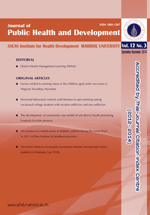Perceived behavioral controls and intention to quit smoking among vocational college students with nicotine addiction and non-addiction
Main Article Content
Abstract
Purposes: This study aimed to examine relationship between direct, indirect perceived behavioral control (PBC) and
intention to quit smoking and to compare the difference of intention, direct and indirect perceived behavioral control toward
quitting smoking during the next six months between vocational college students with nicotine addiction and non-addiction.
Designs: Descriptive correlational study.
Methods: The subjects were 632 students, aged 15-24 years, who studied in vocational colleges (1st - 3rd year) located
in Bangkok. A three-stage stratified cluster sampling was used to identify the subject. Subjects were given a set of question-
naires including Cage questionnaires modified for smoking behavior, intention, direct and indirect PBC, control beliefs and
perceived power to quit smoking during the next six months. Descriptive statistic, Pearson’s product moment correlation
coefficients and independent t-test were used to analyze the data.
Main findings: The correlation amongst direct, indirect PBC and intention to quit smoking more likely to be positive
relationships (r = 0.17 - 0.41, p <0.01). In addition, the nicotine non-addicted students had more perceived behavioral control
toward their quitting smoking and intention to quit smoking than addicted students. Barrier factors that both groups believed
indifferently including the opportunity to be asked to smoke and to see other people smoke. Facilitating factors that nicotine
non-addicted students had more beliefs than addicted students including the opportunity to play sports or do exercise,
find a good role model, receive encouragement from a closed person and have self-determination. In addition, the non-
addicted students had significantly more perceived power of facilitators and barrier factors than the other group.
Conclusion and recommendations: The different beliefs concerning factors that can prevent or facilitate quitting
smoking between students with nicotine addiction and non-addiction should use to be information for campaign of smoking
cessation in vocational college students. In the non-addicted smokers should address on providing no-smoking area,
encouraging the quitting behavior, and enhance supporting from significant persons while in the nicotine addicted smokers
should add on therapeutic factors to control their quitting smoking.


